Effect of refractive index matching layers on optical and electrical properties of top-emitting organic white light emitting devices
2020-05-06WANGGuanghuaDUANLiangfeiZHENGXiaodongDUANYuGAOSiboZHANGJieYANGLiliYANGWeipinCHENXuemeiWANGCanWUYanmingZHONFangSHIMei
WANG Guang-hua, DUAN Liang-fei, ZHENG Xiao-dong, DUAN Yu,2, GAO Si-bo, ZHANG Jie, YANG Li-li,2,YANG Wei-pin, CHEN Xue-mei,2, WANG Can, WU Yan-ming, ZHON Fang, SHI Mei
(1. Yunnan Olightek Opto-electronic Technology Co.,Ltd., Kunming 650223, China;2. Kunming Institute of Physics, Kunming 650223, China;3. North Night Vision Research Institute Group, Kunming 650223, China)
Abstract: In order to analyze the effect of different thickness of C60 on optical and electrical properties of top-emitting OLED, in experiment, the transmittance of ETL/EIL/Mg∶Ag/matching layers were numerically calculated and two top OLED with common cathode configurations were fabricated. The optical and electrical properties of OLED devices prepared with different thickness of C60 refractive index matching layers were analyzed. The results showed, the complex films with different C60 thickness have different transmittance, the complex films have high transmittance in wide range of wavelengths when C60 film thickness is 30~40 nm, the CIEx and CIEy values of transmittance spectra are extremely near to the equal energy (0.33,0.33). In addition, it can be found that the electroluminescence spectra and the chromaticity coordinates of OLED devices are also heavily related to the thickness of C60 refractive index matching layers, which is consistent with the numerical results of transmission spectrum of multilayer (ETL/EIL/Mg∶Ag/C60) at different thickness of C60 thin films and indicate that the luminous brightness and the color coordinates of top-emitting white light devices can be adjusted by different thickness of C60 refractive index matching layer to achieve white light emission close to equal energy.
Key words: organic white light emitting devices; top-emitting; transfer matrix; outcoupling layer
1 Introduction
OLED displays have special advantages such as high resolution, fast response and self-illumination, it is recognized as next-generation display technologies[1-3]. The light is emitted from the top of the device of the top white-emitting OLED devices, white light emitting devices solve the competition between the pixel drive circuit and the emitting area of devices, improves the aperture ratio and easily obtains high-resolution or high-brightness OLED devices[4-5]. The brightness of the OLED devices can be maximized by increasing the light extraction efficiency by specifically using metals with high reflectivity as bottom electrode and the transparent or semitransparent materials as top electrode. However, the microcavity effect caused by the reflection of metal electrodes have an important effect on the photoelectric properties of top light-emitting OLED devices[6-8]. The color coordinates of the OLED device shift according to the change of viewing angle and gradually deviate from white (0.33, 0.33), which limits the practical application performance of illumination and display.
In this paper, the multilayer anode (Al/Mo/MoO3) with high reflectivity and low electrical resistance was prepared on the glass substrate by thin films deposition method. The C60[9-10]transparent conductive oxide layer was prepared as index matching layer to improve device extraction efficiency. In this experiment, the transmission and loss (absorption and reflection) of ETL/EIL/Mg∶Ag/C60 were calculated based on the transfer matrix theory and the optical constants of the material, and the influence of C60 was systematically analyzed.
2 Experiments
The OLED devices were prepared on glass substrate. The substrate was ultrasonically washed by acetone, alcohol and deionized water successively. Metal multi-layers anodes were prepared by thermal evaporation system. Then the OLED devices were fabricated by the thermal evaporation of the organic materials. The film layers were deposited by vacuum vapor deposition at<2×10-4Pa. OLED device structure is metal anode (60 nm) /HIL(15 nm)/HTL(10 nm)/EML(20 nm)/ETL(15 nm)/EIL(10 nm)LiF(1 nm)/Mg∶Ag(10 nm)/C60 (35 nm). The C60 film is used as the out-coupling layers and encapsulation layers. The active area of OLED is controlled at 20 mm2. The electroluminescence spectra is measured using the PR655, the luminance current versus voltage characteristics are measured simultaneously with the Keithley 2400.
3 Results and Discussion
3.1 Transmission and chromaticity coordinate of transmission spectrum of multilayer (ETL/EIL/Mg/Ag/C60) thin films
C60 thin films is firstly used as the out-coupling layer on the surface of cathode to improve the external quantum efficiency of top-emitting organic light emitting devices as a result of it’s high transmittance and refractive index in visible light spectrum. The extinction coefficient (k) and refractive index (n) of C60 thin films is tested with spectroscopic ellipsometry and showed in Fig.1. It can be seen that the extinction coefficient (k)and refractive index (n) is high at short wave, but in visible light spectrum the refractive index (n) is higher than 1.5, the extinction coefficient (k) is close to 0 from the Fig.1.The relationship between the extinction coefficient and the absorption coefficient is:
(1)
the higher ofk, the stronger ofα, the C60 films is very suitable for refractive index matching layers of top-emitting OLED.
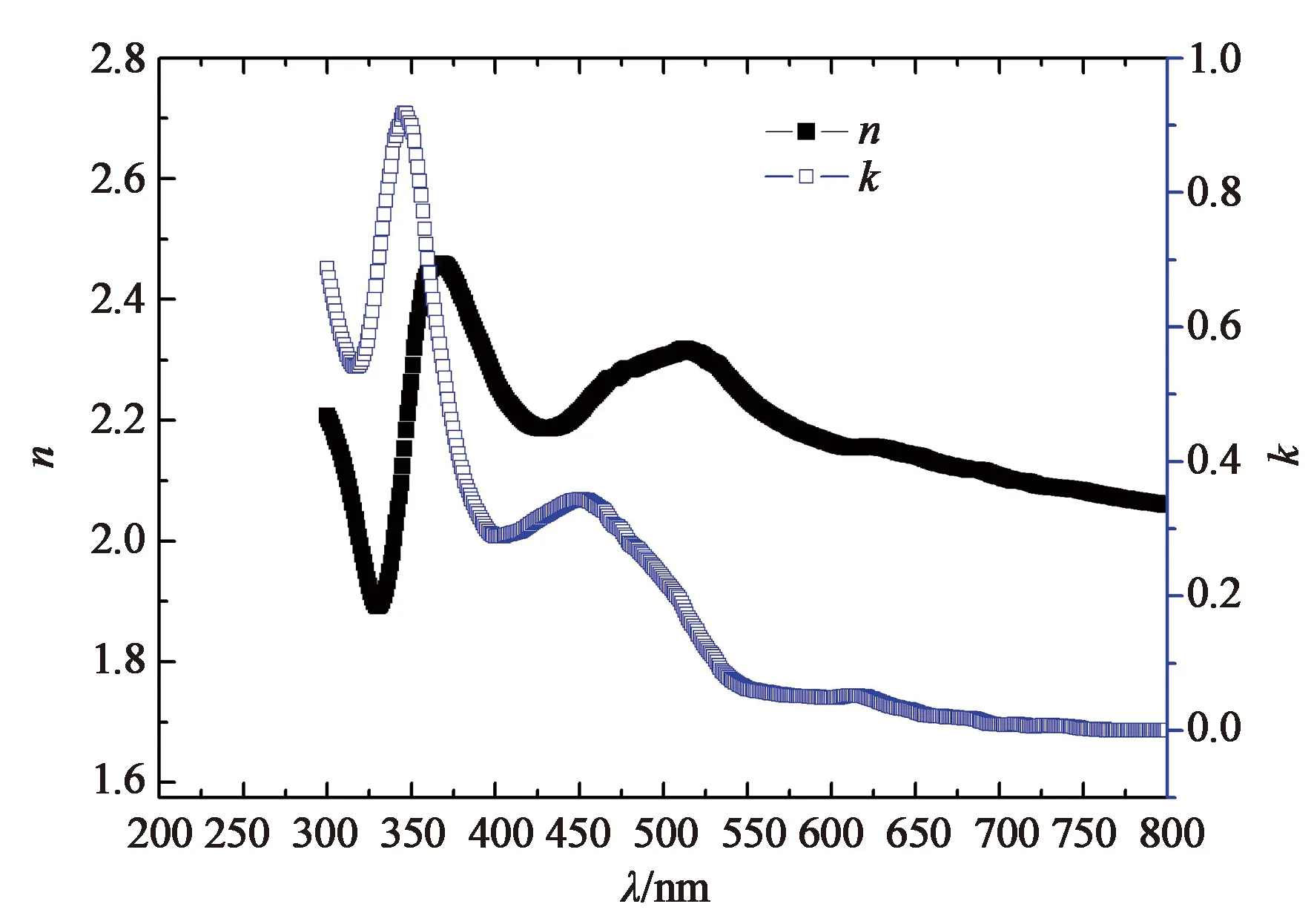
Fig.1 Extinction coefficient (k) and refractive index (n) of C60 thin films
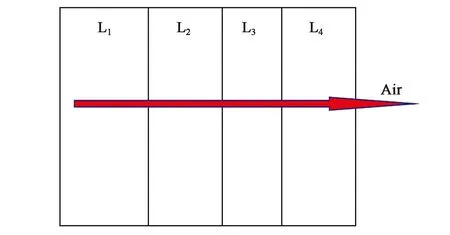
L1: electron transport layers; L2: electron inject layers; L3: Mg/Ag; L4: outcoupling layerFig.2 Structure of multi-layers thin films
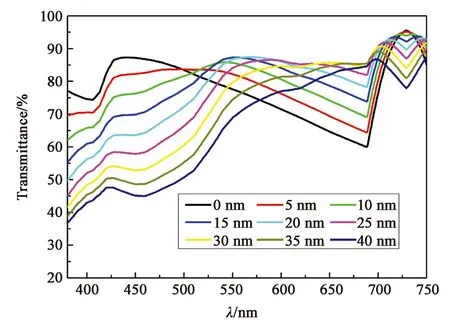
Fig.3 Transmission spectra of multilayer (ETL/EIL/Mg∶Ag/C60) at different thickness of C60 thin films
In order to evaluate the effect of ETL/EIL/Mg∶Ag)/C60 on optical and electrical properties of top-emitting organic white light emitting devices, based on relevant theory, the transmittance of the multilayer films were simulated by matlab,the structure of multi-layers thin films is showed in Fig.2. The transmission spectra of multilayer thin films (ETL/EIL/Mg∶Ag/C60) at different thickness of C60 are illustrated in Fig.3. The experimental results showed that the transmission of multilayer thin films (ETL/EIL/Mg∶Ag/C60) gradually increase according to the increase of C60 thickness of cathode refractive index matching layers, and the transmission in the entire visible range gets to the maximum, when the C60 thickness is controlled at about 30 nm or 40 nm, hereafter the transmission in turn gradually decrease, which confirmed the truth of the obviously effect of C60 thickness variations on the transmission of multilayer (ETL/EIL/Mg∶Ag/C60).
The chromaticity coordinates of transmission spectrum of multilayer (ETL/EIL/Mg∶Ag/C60) at different thickness of C60 were calculated and were listed in Table 1.
Tab.1 Chromaticity coordinates of transmission spectra of multilayer (ETL/EIL/Mg∶Ag/C60) at different thickness of C60
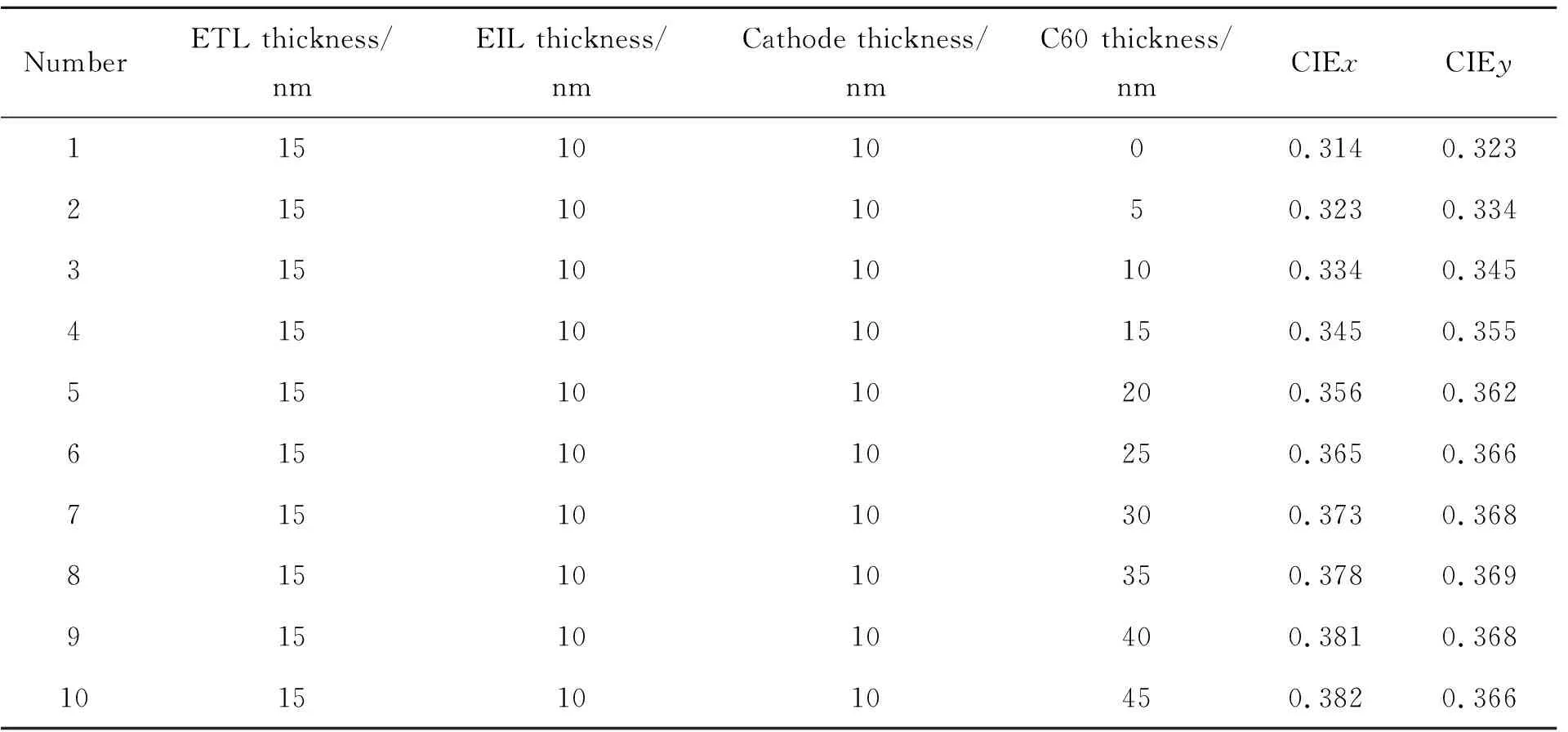
NumberETL thickness/nm EIL thickness/nm Cathode thickness/nm C60 thickness/nm CIExCIEy115101000.3140.323215101050.3230.3343151010100.3340.3454151010150.3450.3555151010200.3560.3626151010250.3650.3667151010300.3730.3688151010350.3780.3699151010400.3810.36810151010450.3820.366
From the Table 1, we can see that the thickness variations of C60 refractive index matching layers have heavily effect on the chromaticity coordinates of transmission spectrum of multilayer, and the CIExor CIEyobviously changes. It is also found that when the thickness variations of C60 refractive index matching layers gets to 30 nm or 40 nm, the CIExand CIEyvalue are extremely near to the white equal energy (0.33,0.33), which is demonstrated that to some extent the thickness is not only related to the transmission, but influences the chromaticity coordinates of transmission spectrum of multilayer (ETL/EIL/Mg∶Ag/C60). When the thickness of C60 refractive index matching layers are controlled at appropriate value, the transmission of multilayer (ETL/EIL/Mg∶Ag/C60) will get to the top and have almost no effect on the chromaticity coordinates of electroluminescence spectra of top-emitting organic light emitting devices.
3.2 Optical and electrical properties of top-emitting organic white light emitting devices
Two top organic white light emitting devices with common cathode configurations were fabricated, and the optical and electrical properties of OLED devices prepared with different thickness of C60 refractive index matching layers were analyzed. The optical and electrical properties of OLED devices prepared with different C60 thickness at the current density of 20 mA/cm2were shown in Table 2. It can be seen from the Table 2, the sample 1# and sample 2# have the same driving voltage, but differs in brightness, effectiveness, and chromaticity coordinates at the current density of 20 mA/cm2. It illustrated that the OLED devices with different thickness of C60 refractive index matching layers have no effect on the electrical properties, but have obviously effect on optical properties. As far as we know, theI-Vcharacteristic of OLED devices mainly depend on an electrode material, organic layer and the interface characteristics in devices, so the refractive index matching layers or thickness variations is not related with the inject, transport, recombination of carriers and produce photons. Consequently, the color of the emitted light, depends on the electronic properties of the organic material in which the photons are generated[11]. The experimental results are consistent with the carriers transport mechanism.
Tab.2 Optical and electrical properties of OLED devices prepared with different C60 thickness at the current density of 20 mA/cm2

SampleC60 thickness/nm Voltage/V brightness/(cd·m-2)effectiveness/(cd·A-1)chromaticity coordinatesCIExCIEy1#409.29691.73.460.3320.3422#809.26575.92.880.3640.411
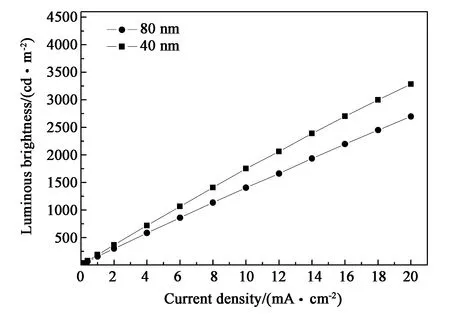
Fig.4 Relationship between the luminous brightness and different C60 thickness of refractive index matching layers
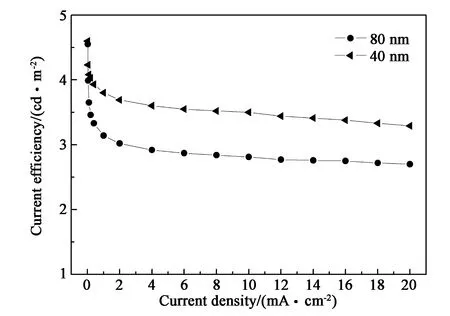
Fig.5 Relationship between the current efficiency and current density at different C60 thickness of refractive index matching layers
It can be seen that the luminous brightness of OLED devices which is prepared by utilizing 40 nm C60 as the refractive index matching layers to improve the extraction efficiency is higher than one which is prepared by utilizing 80 nm C60 as the refractive index matching layers. These experimental results coincided with the previous numerical transmission of multilayer (ETL/EIL/Mg∶Ag/C60). The change between the current efficiency and current density at different C60 thickness of refractive index matching layers is same as before. That is to say, the OLED devices prepared by utilizing 40 nm C60 as the refractive index matching layers have higher luminous brightness and efficiency. Which also explains that the C60 refractive index matching layer with appropriate thickness on the semitransparent cathode can largely improve the transmission of multilayer (ETL/EIL/Mg∶Ag/C60), decrease the loss of light, and finally adjust the external quantum efficiency of OLED devices.
3.3 Luminescence spectrum and chromaticity coordinate shift analysis
The result of C60 thickness at 40 nm and 80 nm is shown in Fig.6. As can be seen from the chart, two OLED devices differ in luminous intensity of three primary color. When the C60 out-coupling layer of cathode makes a choice of 40 nm, the luminous intensity of three primary color is higher than the other one. From this, we can conclude that the certain thickness of C60 out-coupling layer can effectively enhance external quantum efficiency of top-emitting organic white light emitting devices.
The relation between the chromaticity coordinates of OLED devices prepared with refractive index matching layers of C60 which the thickness were respectively controlled at 40 nm and 80 nm and the electric current is shown in Fig.7. From the Fig.7, we can see that the chromaticity coordinates of OLED devices give rise to shift according to the changes of electric current from 0.02~20 mA. And when the electric current increase from 0.02~20 mA, the chromaticity coordinates of OLED devices bring about blue shift, which illustrate that the ratio among the luminous intensity of three primary color changes, the integral area of normalized electroluminescence spectra of three primary color calculated also explain this changes. It is found that when the refractive index matching layers of C60 were respectively controlled at 40 nm and 80 nm, the chromaticity coordinates of two OLED devices is (0.332, 0.342) and (0.364,0.411). The OLED devices fabricated with 40 nm C60 materials as the refractive index matching layers is mostly close to the equal energy (0.33, 0.33), but the other one is away from the equal energy (0.33, 0.33). From the above analysis, it is found that the electroluminescence spectrum and chromaticity coordinates of top-emitting OLED devices are closely related to C60 thickness, which is consistent with the numerical results of transmission spectrum of multilayer (ETL/EIL/Mg∶Ag/C60) at different thickness of C60 thin films.
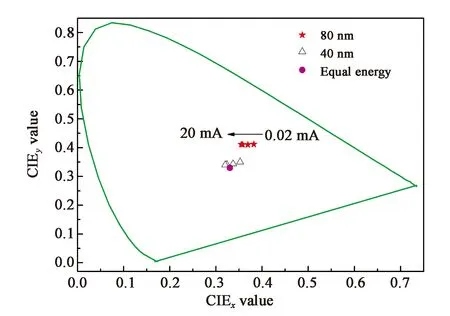
Fig.7 Chromaticity coordinates of OLED devices prepared with different C60 thickness of refractive index matching layers
4 Conclusion
Based on relevant theory, the transmission of multilayer (ETL/EIL/Mg∶Ag)/C60) thin films were numerically calculated with matlab program and the top organic white light emitting devices with common cathode configurations were fabricated. The optical and electrical properties of OLED devices prepared with different thickness of C60 refractive index matching layers were analyzed. In addition, the normalized electroluminescence spectra and chromaticity coordinates shift of OLED devices prepared with refractive index matching layers of C60 which the thickness were respectively controlled at 40 nm and 80 nm were analyzed. The experimental results showed there were biggish difference in optical transmittance and the chromaticity coordinates of transmission spectrum of ETL/EIL/Mg∶Ag/matching layers with different thickness of C60. The C60 refractive index matching layers or thickness variations are not related with the injection, transport, recombination of carriers and produce photos. The study found that the electroluminescence spectrum and chromaticity coordinates of top-emitting OLED devices are closely related to C60 thickness, which is consistent with the numerical results of transmission spectrum of multilayer (ETL/EIL/Mg∶Ag/C60) at different thickness of C60 thin films.
